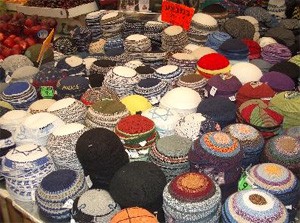HEAD COVERINGS FOR MEN
Yarmulke – Kippah – Skullcap – Hat
‘One should not walk bare-headed (the distance of) four cubits.’
‘Small children should (also) be brought up to cover their heads.’ (Shulchan Aruch, Orach Chayim, Ch.2)

Tradition, and not an explicit command in the Bible, requires men to cover their heads as a sign of humility and awareness of God’s presence. Head covering for men was optional in the days of the Talmud, but later became the expected norm of behaviour. The Code of Law states, ‘It is a custom not to walk bareheaded under the heavens.’
Halachah (Jewish law) states that it is forbidden for men to walk four cubits (about 8 feet or 2.5 metres) with an uncovered head. It is forbidden to go any distance at all without a head covering, according to some authorities. Halachah also forbids a man to say a prayer with the name of G-d or to study Torah without a head covering.
It is stated in the Talmud that the mother of Rabbi Nachman bar Yitzchak would not allow him to go with his head uncovered. She said, “Cover your head in order that you should have the fear of heaven upon you.”
This practice later spread to European Jewry as one worthy of implementation. In the 17th century men began wearing head coverings at home because of the prayers and blessings at meals and other times.
Today the practice is widespread among observant Jewish men to always wear a head covering (except when sleeping, showering or bathing). It is a distinctly Jewish way to show reverence for God. The kippah (skullcap) has assumed great status as a badge of Jewish identity.
Interested in crocheting a kippah? Then read our page How to Crochet A Kippah.
HEAD COVERINGS FOR WOMEN
Kisui Rosh – Sheitel – Wig – Kerchief
As with men, for Jewish women it is tradition, and not an explicit command from the Bible, which requires them to cover their heads as a sign of humility and modesty. The idea is that the display of a woman’s hair is very sexual and as such, should be hidden from all men except her own husband.
The Zohar states (III, 126a) in Parshat Naso, (Mishnah Brurah, Laws of Kriat Shema, Ch. 75) that if a woman covers her head in public: “Her children will enjoy increased stature over other children; moreover, her husband shall be blessed with all blessings, blessings of above and blessings of below, with wealth, with children and grandchildren…”
These days, religious women who choose to cover their heads do so with scarves, wigs or snoods, depending on their cultural background.


